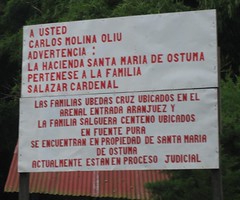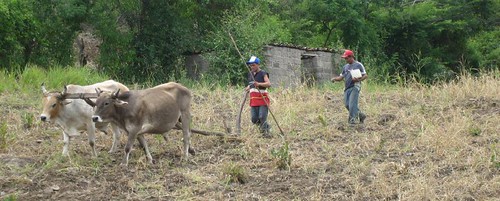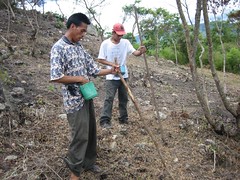
Private property in Nicaragua is a dubious concept in the process of being rediscovered. The country is been recovering from the revolutionaries years in which most of the productive land was confiscated by the Frente Sandinista de Liberacion Nacional (FSNL) and reorganized into cooperatives and Unidades de Produccion Estatal (UPE. State Production Units). The policies enacted during the revolutionary period created repercussions still seen today: farms with several titles, families disunited, violence over land ownership, and most important, a huge lost in agricultural productivity and national welfare.
The initial plans of the revolution of 1979 were to take possession of all the property own by Somozas’ family or by someone else who had gained it through positions within the dictatorship. There was little opposition to these actions as the Somoza regime had control and ownership of whole range of companies in several sectors: mining, construction, agriculture, banking etc. Before the revolution, even the well-off private sector was getting uncomfortable with the dynasty because they saw it as unfair state competition. For the general NIcaraguan public, this was just one of the many reasons to hate the regime and hope for change.
The initial plans for change, however, would resemble little to what most Nicaraguans had hopped the so-called “land reform” would bring. In fact, after Somoza and its followers were striped away of all property, the Sandinistas created another law in which anyone absent from Nicaragua for more than 6 months would have their property taken away.

These laws created an atmosphere in which private property was constantly been violated and confiscation became a normal routine. The allocation of lands and properties was completely based in clientelism bias towards sandinitas and, of course, those within the party would get the largest chunks. Holding a position in a public office was a tool to return favors to those you like, a patronage system still very common today and very similar to the years of the dictatorship. Talk to Nicaraguans and you’ll hear hundreds of stories of poor families that had their couple acres taken away by the Sandinistas, not because they were relatives of Somoza or because they went outside Nicaragua, but just because their land was nice to the eyes of somebody with party connections.
It didn’t matter anymore if you had been a staunchly opponent of the Somoza regime and had even supported the revolutionary effort, if you own a farm with cattle, cotton, tobacco, coffee, sugar cane or other goods, chances were that it would be confiscated under the most irrational excuses.
Not surprisingly, the productive sector of Nicaragua went into exile, jointed or financed the counter revolutionary force, or simply gave up. These actions affected the country’s economy enormously: in Esteli, the town where I live, after the Sandinistas took power, the owners of the tabacaleras (tobacco processing plants) ran away fearing retributions from the FSNL. Without owners and technicians, the plants were abandoned and thousands of women went unemployed.
Same story with sugar cane mills, coffee farms, and cotton plantations. Of course the U.S trade embargo played an important role in the economic crisis as the U.S was one of the main clients of Nicaraguan goods. However, the effect of the embargo was shorttermed and miniscule against the disincentives created by the Sandinistas in the agricultural sector as a whole.
Disincentives and lack of rationale was common place in the agricultural sector during those days. For instance, the Sandinistas tried to promote the utilization of Central Pivot Irrigation systems, a result of the latest in technology in the developed world. Of course, for a former farm worker who could barely read and write this new piece of technology resulted simply unsuitable. The irrigation pipes probably end up melted, same fate suffered by the Robotic Milking Systems, imported from Eastern Europe.

But this nonsense top-down, technology transfer approach to agriculture was not the only reason for failure: the social structure of the rural sector was also disrupted. Farmers where not allowed to commerce their goods, even in miniscule amounts. All output needed to be collected, transported, store, and sold by the government. Ignoring the common traditions of the rural people and imposing an alien Marxist system on them was deemed to fail.
Another ridiculous policy took place when it came to harvesting the crops: thousands of students from the cities were sent to the rural regions to do these tasks. Without any experience, away from their families, and under very harsh conditions, it resulted impossible to expect a high school kid to collect cotton or to cut sugar cane under the inferno heat of Chinandega. Some farmers would even reject the students knowing that they could easily ruin the plants and the harvest. Thankfully, the policy was dropped after three years.
Finally, another disincentive created by the Sandinistas was the so called “Piñata” in which farmers were given almost everything for free. Free land, free seeds, free technical assistance, and even free labor, all resulting in a rural sector that still wants everything for free. Visit the farmers today and see their faces when you tell them of their financial contribution to the project, not happy certainly. This dependacy in foreign assistance (central government, or aid agencies), I think is, a rooted problem that will take generations to solve.
Nicaraguan agricultural sector during the Sandinista years served as a sort of playground for the politicians in the central government who tried to implement what translated Marxist literature said. This improvised lab resulted on a series of failures still seem today. With almost 30% of the population undernourished, is depressing to realize that this was a direct result of a bunch of revolutionaries trying to “help” the people.

1 comment:
Hello Everybody,
My name is Ahmad Asnul Brunei, I contacted Mr Osman Loan Firm for a business loan amount of $250,000, Then i was told about the step of approving my requested loan amount, after taking the risk again because i was so much desperate of setting up a business to my greatest surprise, the loan amount was credited to my bank account within 24 banking hours without any stress of getting my loan. I was surprise because i was first fall a victim of scam! If you are interested of securing any loan amount & you are located in any country, I'll advise you can contact Mr Osman Loan Firm via email osmanloanserves@gmail.com
LOAN APPLICATION INFORMATION FORM
First name......
Middle name.....
2) Gender:.........
3) Loan Amount Needed:.........
4) Loan Duration:.........
5) Country:.........
6) Home Address:.........
7) Mobile Number:.........
8) Email address..........
9) Monthly Income:.....................
10) Occupation:...........................
11)Which site did you here about us.....................
Thanks and Best Regards.
Derek Email osmanloanserves@gmail.com
Post a Comment